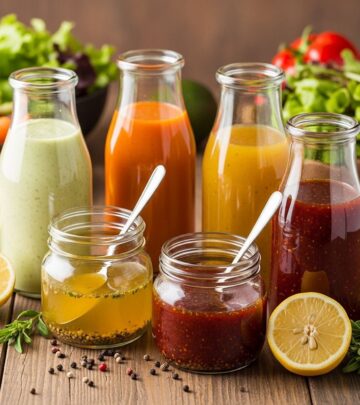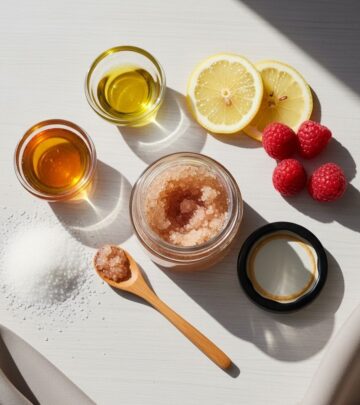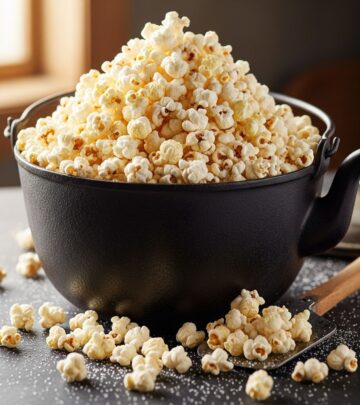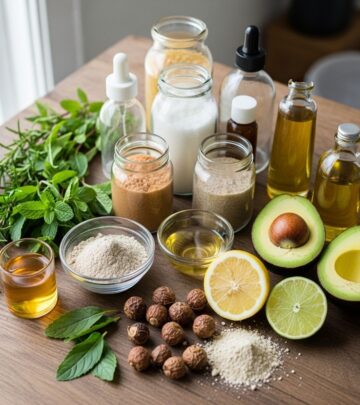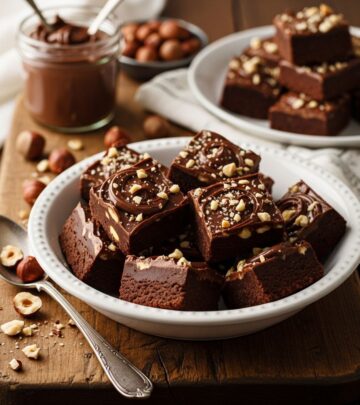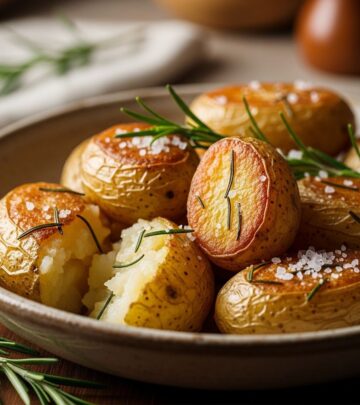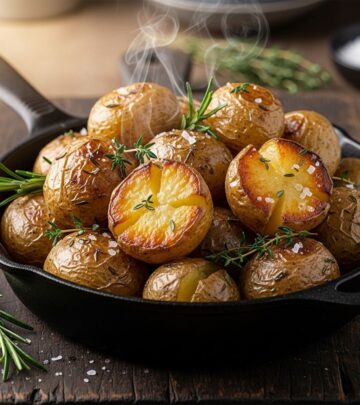Sautéed Mushrooms Recipe: 20-Minute Flavor-Packed Side Dish
Transform humble button mushrooms into a rich, flavorful side that complements any main course
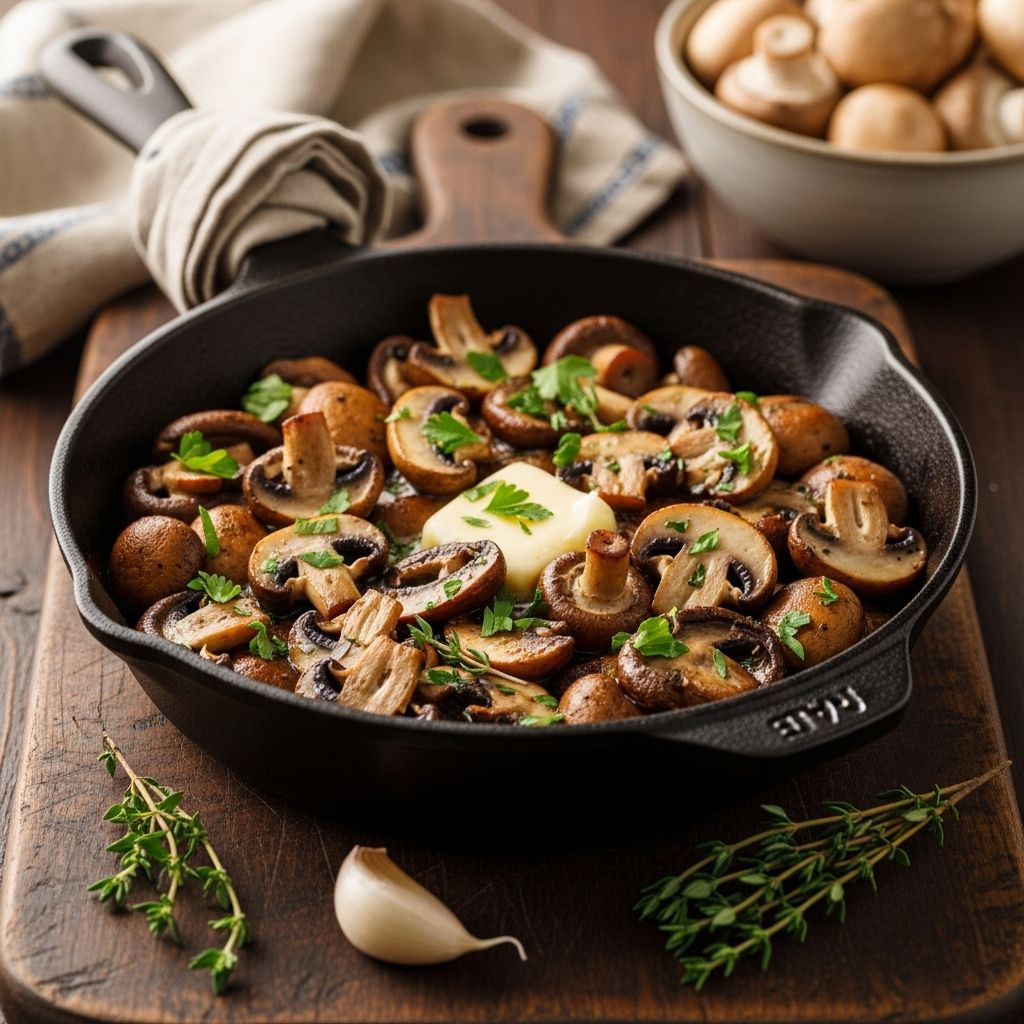
Image: HearthJunction Design Team
Mouthwatering Sautéed Mushrooms: The Perfect Side Dish
There’s something magical about perfectly sautéed mushrooms. When cooked correctly, these humble fungi transform into savory, meaty morsels that can elevate almost any meal. The combination of earthy mushrooms with rich butter, aromatic garlic, and a splash of wine creates an irresistible side dish that pairs wonderfully with everything from grilled steaks to roasted chicken. This recipe for superb sautéed mushrooms delivers exceptional flavor with minimal effort, making it a must-have in your culinary repertoire.
What sets these sautéed mushrooms apart is the careful balance of flavors and textures. The mushrooms are cooked until they’re deeply browned and caramelized, concentrating their natural umami essence. A clever combination of olive oil and butter provides the perfect fat blend for sautéing—the oil prevents the butter from burning while the butter adds incredible richness. The addition of teriyaki sauce brings a wonderful depth of flavor with its sweet-savory profile, while a splash of red cooking wine adds complexity and helps deglaze the pan, incorporating all those delicious browned bits back into the dish.
Why You’ll Love These Sautéed Mushrooms
Before diving into the recipe details, let’s talk about what makes these sautéed mushrooms truly special:
- Depth of Flavor: The combination of butter, olive oil, teriyaki sauce, and wine creates layers of flavor that far exceed typical sautéed mushrooms.
- Versatility: These mushrooms work beautifully as a side dish, topping for steaks, addition to pasta, or even as a standalone appetizer.
- Simple Ingredients: Despite the complex flavor, the ingredient list is straightforward and likely includes items you already have in your pantry.
- Quick Preparation: From start to finish, this dish comes together in under 20 minutes, making it perfect for both weeknight meals and special occasions.
- Crowd-Pleaser: Even those who typically aren’t mushroom enthusiasts often find themselves won over by this preparation method.
Understanding the Ingredients
The beauty of this recipe lies in its carefully selected ingredients that work together harmoniously to create a flavor profile greater than the sum of its parts. Let’s examine each component and its role in creating these exceptional sautéed mushrooms:
The Fats: Olive Oil and Butter
The combination of olive oil and butter creates the perfect cooking medium for mushrooms. Olive oil has a higher smoke point than butter, which helps prevent the butter from burning during the sautéing process. Meanwhile, the butter contributes a rich, nutty flavor that can’t be replicated by oil alone. As the butter browns slightly during cooking, it develops complex notes that complement the earthiness of the mushrooms beautifully.
For this recipe, you’ll need 3 tablespoons of each. Using equal parts creates a balanced fat base that allows for proper browning while infusing the mushrooms with buttery goodness. If you prefer, you can experiment with different oils such as avocado oil or even a touch of sesame oil for an Asian-inspired variation.
The Star: Button Mushrooms
Button mushrooms, also known as white mushrooms, are the perfect canvas for this recipe. Their mild flavor allows them to absorb the other ingredients while still maintaining their distinct mushroom character. One pound of sliced mushrooms is ideal for serving about four people as a side dish.
When selecting button mushrooms, look for specimens that are firm, uniform in color, and free from dark spots or sliminess. While pre-sliced mushrooms can save time, whole mushrooms will typically stay fresher longer and allow you to control the thickness of the slices.
Though this recipe calls specifically for button mushrooms, you can certainly experiment with other varieties. Cremini mushrooms (baby portobellos) make an excellent substitute, offering a slightly deeper flavor. For a gourmet twist, consider using a mixture of mushroom varieties such as shiitake, oyster, or maitake mushrooms.
Flavor Enhancers: Wine and Teriyaki Sauce
A tablespoon of red cooking wine adds acidity and depth to the dish. The alcohol helps release flavor compounds that are not water-soluble, bringing out nuances in the mushrooms that might otherwise remain hidden. As the wine cooks down, it concentrates, leaving behind its essence without any alcoholic taste.
The tablespoon of teriyaki sauce might seem unusual in a mushroom recipe, but it’s actually a stroke of genius. Teriyaki sauce contains soy sauce (umami), sugar (sweetness), and mirin (acidity), creating a balanced flavor enhancer that complements mushrooms perfectly. The slight sweetness helps encourage caramelization, while the umami compounds in the soy sauce amplify the natural savoriness of the mushrooms.
Aromatics and Seasonings
Fresh minced garlic provides a pungent aromatic base that infuses the mushrooms as they cook. For this recipe, 2-3 cloves of garlic, finely minced, will provide the right amount of garlic flavor without overwhelming the other ingredients.
The seasoning is kept simple with just garlic powder and black pepper. The garlic powder reinforces the fresh garlic flavor and distributes it more evenly throughout the dish. Black pepper adds a subtle heat that cuts through the richness. Note that this recipe doesn’t call for additional salt, as the teriyaki sauce typically provides enough sodium. However, you can adjust to taste if needed.
The Art of Sautéing Mushrooms
Properly sautéing mushrooms is a culinary skill that, once mastered, will serve you well in countless recipes. The process for these superb sautéed mushrooms is straightforward but pays attention to a few key details that make all the difference in the final result.
Preparation Steps
Before you begin cooking, it’s important to properly prepare your mushrooms:
- Cleaning: Contrary to popular belief, mushrooms should not be soaked in water as they absorb moisture like sponges. Instead, gently wipe them with a damp paper towel or use a mushroom brush to remove any dirt.
- Slicing: Slice the mushrooms to a uniform thickness of about 1/4 inch. This ensures they’ll cook evenly and creates a pleasant texture in the final dish.
- Mincing Garlic: Finely mince the garlic cloves so they’ll distribute evenly throughout the dish.
- Measuring Ingredients: Have all your ingredients measured and ready before you begin cooking, as the process moves quickly once the mushrooms hit the pan.
The Cooking Process
Now that everything is prepared, here’s a detailed breakdown of the cooking process:
- Heat the Fat: Begin by heating the olive oil and butter in a large skillet over medium-high heat. Allow the butter to melt completely and begin to foam slightly, which indicates it’s hot enough to properly sauté.
- Add the Mushrooms: Add the sliced mushrooms to the hot pan, spreading them out as much as possible. It’s important not to overcrowd the pan, as this will cause the mushrooms to steam rather than brown. If necessary, cook in batches.
- Initial Browning: Allow the mushrooms to cook undisturbed for 2-3 minutes. This gives them time to begin releasing their moisture and develop a golden-brown color on one side.
- Stir and Continue Cooking: Stir the mushrooms and continue cooking for another 2-3 minutes, allowing them to brown on multiple sides. You’ll notice they begin to shrink as they release their moisture.
- Add Flavorings: Once the mushrooms have reduced in volume by about half and most of their moisture has evaporated, add the red cooking wine, teriyaki sauce, minced garlic, garlic powder, and black pepper.
- Simmer and Reduce: Reduce the heat to medium-low and continue cooking, stirring frequently, for another 5-7 minutes. This allows the mushrooms to absorb the flavors while the liquid reduces to a glossy glaze that coats each slice.
- Final Cooking: The mushrooms are done when they’re tender throughout and deeply browned, with very little liquid remaining in the pan. The sauce should have reduced to a rich glaze that clings to the mushrooms.
Serving Suggestions
These versatile sautéed mushrooms pair beautifully with a wide variety of main courses. Here are some excellent serving suggestions:
Perfect Pairings for Protein
Sautéed mushrooms have a natural affinity for meat dishes, particularly beef. Consider serving them:
- Alongside a perfectly grilled steak for a classic steakhouse experience
- Atop a juicy hamburger as a gourmet topping
- Next to roasted chicken for an earthy complement to poultry
- With grilled pork chops for a savory enhancement
- Alongside baked or grilled fish for a surf-and-turf inspired pairing
Vegetarian Applications
The meaty texture and umami-rich flavor of these mushrooms make them equally at home in vegetarian meals:
- Stirred into risotto just before serving
- Tossed with pasta and a touch of cream for a simple but elegant dish
- As a topping for polenta with shaved Parmesan
- Piled onto toast with a spread of ricotta for an elevated bruschetta
- Added to grain bowls for a protein-like component
Make-Ahead and Storage Tips
These sautéed mushrooms can be made ahead of time and stored in the refrigerator for up to 3 days. They actually improve in flavor as they sit, making them an excellent prep-ahead side dish. To reheat, simply warm gently in a skillet over medium-low heat or microwave until just heated through.
You can also freeze these sautéed mushrooms for up to 2 months. To freeze, cool completely, then transfer to an airtight container. Thaw overnight in the refrigerator before reheating.
Variations and Adaptations
While this recipe is perfect as written, there are numerous ways to adapt it to suit different tastes or dietary requirements:
Herb Additions
Fresh herbs can be added at the end of cooking for a bright flavor contrast:
- Chopped fresh thyme or rosemary for a traditional French flavor
- Minced fresh parsley for brightness and color
- Snipped chives for a mild onion note
- Fresh basil for an Italian-inspired version
Dietary Adaptations
This recipe can be easily modified for different dietary needs:
- Vegan Version: Replace the butter with additional olive oil or a plant-based butter alternative
- Gluten-Free: Ensure your teriyaki sauce is gluten-free or substitute with tamari and a touch of honey
- Low-Sodium: Use a low-sodium teriyaki sauce or replace with a smaller amount of low-sodium soy sauce and a pinch of sugar
- Alcohol-Free: Substitute the red cooking wine with vegetable broth or pomegranate juice
Nutritional Benefits of Mushrooms
Beyond their delicious taste, mushrooms offer impressive nutritional benefits. Button mushrooms are low in calories but rich in nutrients, making this dish as healthy as it is tasty. They provide:
- B vitamins, including niacin and riboflavin, which help convert food into energy
- Selenium, a mineral that supports immune function and acts as an antioxidant
- Copper, which plays a role in iron metabolism and nerve health
- Potassium, important for heart health and fluid balance
- Dietary fiber, supporting digestive health
- Protein, with mushrooms providing more protein than most vegetables
Frequently Asked Questions (FAQs)
Q: Why are my sautéed mushrooms watery instead of browned?
A: There are several common reasons for watery mushrooms: overcrowding the pan, which traps steam; not cooking at a high enough temperature initially; or not allowing enough time for the moisture to evaporate. Make sure to use a large enough pan, maintain adequate heat, and be patient as the moisture cooks off.
Q: Can I use different types of mushrooms in this recipe?
A: Absolutely! While button mushrooms are specified, this technique works beautifully with cremini, shiitake, oyster, or portobello mushrooms. Each variety will bring its own unique flavor profile to the dish. For the best results, choose mushrooms of similar size or cut larger ones to match the cooking time of smaller varieties.
Q: Is it necessary to wash mushrooms before cooking?
A: Mushrooms are grown in a sterile medium, so they don’t typically have soil on them. A gentle wipe with a damp paper towel is usually sufficient. If they’re particularly dirty, a quick rinse is fine, but do it right before cooking and don’t soak them, as they absorb water like sponges.
Q: Can I make these mushrooms ahead of time for a dinner party?
A: Yes! These sautéed mushrooms reheat beautifully and actually develop more flavor as they sit. Make them up to a day ahead, refrigerate, and then gently reheat in a skillet over medium-low heat just before serving.
Q: What can I substitute for red cooking wine if I don’t have any?
A: Red wine vinegar diluted with a bit of water or broth makes a good substitute. You could also use vegetable or beef broth, pomegranate juice, or even a splash of balsamic vinegar for acidity. Each will alter the flavor profile slightly but still produce delicious results.
Mastering the art of sautéed mushrooms is a culinary skill that will serve you well for years to come. This recipe, with its perfect balance of fats, umami-rich ingredients, and simple seasonings, transforms humble button mushrooms into a side dish worthy of the finest restaurants. Whether you’re serving them alongside a perfectly grilled steak, incorporating them into a vegetarian pasta dish, or simply enjoying them on toast, these superb sautéed mushrooms are sure to impress.
References
- https://www.allrecipes.com/recipe/222795/superb-sauteed-mushrooms/
- https://www.allrecipes.com/recipe/64961/sauteed-mushrooms/
- https://www.allrecipes.com/recipe/61791/sauteed-mushrooms-in-garlic/
- https://www.allrecipes.com/recipe/222793/sauteed-mushrooms-quick-and-simple/
- https://www.pinterest.com/ideas/superb-saut%C3%A9ed-mushrooms-allrecipes/952370316267/
Read full bio of medha deb

